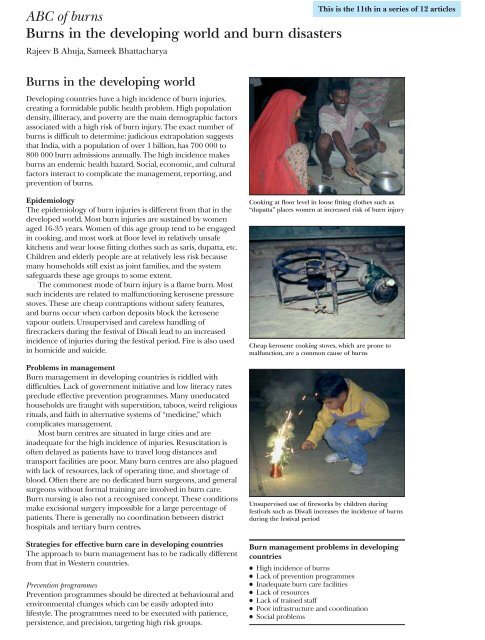ABC of Burns
Create successful ePaper yourself
Turn your PDF publications into a flip-book with our unique Google optimized e-Paper software.
<strong>ABC</strong> <strong>of</strong> burns<br />
<strong>Burns</strong> in the developing world and burn disasters<br />
Rajeev B Ahuja, Sameek Bhattacharya<br />
<strong>Burns</strong> in the developing world<br />
Developing countries have a high incidence <strong>of</strong> burn injuries,<br />
creating a formidable public health problem. High population<br />
density, illiteracy, and poverty are the main demographic factors<br />
associated with a high risk <strong>of</strong> burn injury. The exact number <strong>of</strong><br />
burns is difficult to determine: judicious extrapolation suggests<br />
that India, with a population <strong>of</strong> over 1 billion, has 700 000 to<br />
800 000 burn admissions annually. The high incidence makes<br />
burns an endemic health hazard. Social, economic, and cultural<br />
factors interact to complicate the management, reporting, and<br />
prevention <strong>of</strong> burns.<br />
This is the 11th in a series <strong>of</strong> 12 articles<br />
Epidemiology<br />
The epidemiology <strong>of</strong> burn injuries is different from that in the<br />
developed world. Most burn injuries are sustained by women<br />
aged 16-35 years. Women <strong>of</strong> this age group tend to be engaged<br />
in cooking, and most work at floor level in relatively unsafe<br />
kitchens and wear loose fitting clothes such as saris, dupatta, etc.<br />
Children and elderly people are at relatively less risk because<br />
many households still exist as joint families, and the system<br />
safeguards these age groups to some extent.<br />
The commonest mode <strong>of</strong> burn injury is a flame burn. Most<br />
such incidents are related to malfunctioning kerosene pressure<br />
stoves. These are cheap contraptions without safety features,<br />
and burns occur when carbon deposits block the kerosene<br />
vapour outlets. Unsupervised and careless handling <strong>of</strong><br />
firecrackers during the festival <strong>of</strong> Diwali lead to an increased<br />
incidence <strong>of</strong> injuries during the festival period. Fire is also used<br />
in homicide and suicide.<br />
Problems in management<br />
Burn management in developing countries is riddled with<br />
difficulties. Lack <strong>of</strong> government initiative and low literacy rates<br />
preclude effective prevention programmes. Many uneducated<br />
households are fraught with superstition, taboos, weird religious<br />
rituals, and faith in alternative systems <strong>of</strong> “medicine,” which<br />
complicates management.<br />
Most burn centres are situated in large cities and are<br />
inadequate for the high incidence <strong>of</strong> injuries. Resuscitation is<br />
<strong>of</strong>ten delayed as patients have to travel long distances and<br />
transport facilities are poor. Many burn centres are also plagued<br />
with lack <strong>of</strong> resources, lack <strong>of</strong> operating time, and shortage <strong>of</strong><br />
blood. Often there are no dedicated burn surgeons, and general<br />
surgeons without formal training are involved in burn care.<br />
Burn nursing is also not a recognised concept. These conditions<br />
make excisional surgery impossible for a large percentage <strong>of</strong><br />
patients. There is generally no coordination between district<br />
hospitals and tertiary burn centres.<br />
Strategies for effective burn care in developing countries<br />
The approach to burn management has to be radically different<br />
from that in Western countries.<br />
Prevention programmes<br />
Prevention programmes should be directed at behavioural and<br />
environmental changes which can be easily adopted into<br />
lifestyle. The programmes need to be executed with patience,<br />
persistence, and precision, targeting high risk groups.<br />
Cooking at floor level in loose fitting clothes such as<br />
“dupatta” places women at increased risk <strong>of</strong> burn injury<br />
Cheap kerosene cooking stoves, which are prone to<br />
malfunction, are a common cause <strong>of</strong> burns<br />
Unsupervised use <strong>of</strong> fireworks by children during<br />
festivals such as Diwali increases the incidence <strong>of</strong> burns<br />
during the festival period<br />
Burn management problems in developing<br />
countries<br />
x High incidence <strong>of</strong> burns<br />
x Lack <strong>of</strong> prevention programmes<br />
x Inadequate burn care facilities<br />
x Lack <strong>of</strong> resources<br />
x Lack <strong>of</strong> trained staff<br />
x Poor infrastructure and coordination<br />
x Social problems



